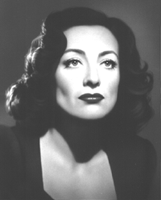
Crawford was born in San Antonio, Texas in 1904 as Lucille Le Sueur, although her friends and family called her "Billie." She was not named Joan Crawford until much later, when her Hollywood agency ran a contest through a fan magazine to find a suitable name for the emerging star. Her parents divorced when she was a small child, leaving Billie and her older brother, Hal, with their mother, who remarried soon after. That marriage did not work out either, but their mom found another husband, one "who apparently showed more than paternal interest in teen-aged Lucille" (Harvey, 20). After another divorce, the small family moved to Kansas City, where Ms. Cassin raised her two children in a cheap hotel, working as a single mom in a laundry. She worked hard to give her children what they wanted (like Mildred Pierce), sending Lucille to academies.
Yet the academic lifestyle didn't quite suit her, so young Joan Crawford ended up beginning her career in the entertainment industry through dance routines at a club in Detroit at the age of 15. She was soon discovered, joining MGM when she was a 16-year-old, moving to Los Angeles. There she starred in silent films (such as Sally, Irene & Mary; The Taxi Dancer; The Boob; The Unknown), making 20 of them between 1925 and 1929 -- usually being cast as the quintessential flapper girl -- since it was the Roaring Twenties, a time when the movie industry was still in development. Our Dancing Daughters was the film that finally made her a true star in 1928. Here is what The Joan Crawford Home Page had to say about Hollywood's two momentous events of the time:
One event was the advent of sound - the "talkies" - an occurrence that ended
the careers of many of the biggest silent film stars. Crawford - with her
relatively strong speaking voice - came through the transition to talkies
unscathed. The other momentous event that happened near the end of the
decade was the onset of the Great Depression. The flapper girl - and the
frivolity and carefree spirit she embodied - was a thing of the past. As a
result, Crawford - the consummate flapper - had to start from scratch,
totally restructuring her image into one more in tune with the mood of the
times. Her first talkie, Untamed, which was released in 1929, featured a more
subdued, mature Joan Crawford. Fortunately, the movie was a success.
Crawford experienced major fame in the next decade, voted Hollywood's top female star and box office draw in 1930. The other two big stars of the time were Greta Garbo and Norma Shearer, yet Crawford was the only one of the three portraying the typical all-American girl.
Crawford stayed with MGM until 1943, when she joined Warner Brothers. As she explains it, "I loved MGM -- it was home. But I longed for challenging parts and I wasn't getting them. There were top executives who thought me all washed up." She proved those executives wrong when won the 1945 Academy Award for Best Actress for her first film with Warner Bros.: Mildred Pierce (Michael Curtiz, 1945). Some thought this was somewhat of a surprise since the quality of her acting and depth of her roles were not was she was necessarily known for before then. This situation is an illustration of a theory claiming that Crawford represented a certain paradox. Assuming that a star can embody an ideology (reflecting the audience/society's sentiments of the time), Pamela Robertson proposes that Crawford dealt with the contradiction of female success versus the social expectations of women's roles, managing both. Her work in Mildred Pierce is an excellent example, for she can profess success with her Academy Award, while also defying the expectations about the desirability of older female stars (95). Robertson goes on to explain that Mildred Pierce also exposes this contradiction, "because Mildred's success conflicts with the postwar ideology that demands that women give up their careers" (95, 96).
Joan Crawford had many working-class women fans, for she was considered the rags-to-riches symbol of professional success. Crawford once claimed, in an interview, that she could really identify with the character of Mildred Pierce, and the parallels are indeed quite clear. That is perhaps a reason why she was cast as Mildred, since her real-life persona could only strengthen the audience's perception of the movie's characters. Crawford was a self-made star, and her roles were often heroines in the working class, striving for a better life. This shows that the boundaries between life on and off screen are not always so clear, for both can work in each others' favor (or disfavor) sometimes, both for the actors and the movie industry as a whole.
Bibliography: Harvey, Stephen. Joan Crawford. New York: Pyramid Publications.1974.
Quirk, Lawrence J. The Complete Films of Joan Crawford. Secaucus, New Jersey: The Citadel Press. 1968.
Robertson, Pamela. Guilty Pleasures. Durham & London: Duke University Press. 1996.